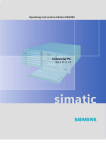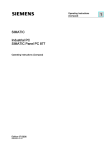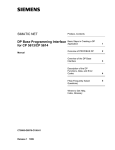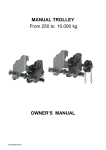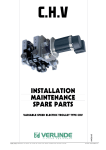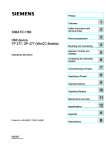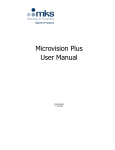Download Siemens simatic PCIL43 Technical data
Transcript
Getting Started Edition 09/2005 Industrial PC Rack PC IL 43 simatic DOCUMENTATION Introduction 1 Description 2 SIMATIC Application Planning 3 Industrial PC Rack PC IL 43 Mounting 4 Connecting 5 Commissioning 6 Dimension drawings 7 Appendix A Getting Started Edition 09/2005 A5E00432882-01 Safety Guidelines This manual contains notices you have to observe in order to ensure your personal safety, as well as to prevent damage to property. The notices referring to your personal safety are highlighted in the manual by a safety alert symbol, notices referring only to property damage have no safety alert symbol. These notices shown below are graded according to the degree of danger. Danger indicates that death or severe personal injury will result if proper precautions are not taken. Warning indicates that death or severe personal injury may result if proper precautions are not taken. Caution with a safety alert symbol, indicates that minor personal injury can result if proper precautions are not taken. Caution without a safety alert symbol, indicates that property damage can result if proper precautions are not taken. Notice indicates that an unintended result or situation can occur if the corresponding information is not taken into account. If more than one degree of danger is present, the warning notice representing the highest degree of danger will be used. A notice warning of injury to persons with a safety alert symbol may also include a warning relating to property damage. Qualified Personnel The device/system may only be set up and used in conjunction with this documentation. Commissioning and operation of a device/system may only be performed by qualified personnel. Within the context of the safety notes in this documentation qualified persons are defined as persons who are authorized to commission, ground and label devices, systems and circuits in accordance with established safety practices and standards. Prescribed Usage Note the following: Warning This device may only be used for the applications described in the catalog or the technical description and only in connection with devices or components from other manufacturers which have been approved or recommended by Siemens. Correct, reliable operation of the product requires proper transport, storage, positioning and assembly as well as careful operation and maintenance. Trademarks All names identified by ® are registered trademarks of the Siemens AG. The remaining trademarks in this publication may be trademarks whose use by third parties for their own purposes could violate the rights of the owner. Disclaimer of Liability We have reviewed the contents of this publication to ensure consistency with the hardware and software described. Since variance cannot be precluded entirely, we cannot guarantee full consistency. However, the information in this publication is reviewed regularly and any necessary corrections are included in subsequent editions. Siemens AG Automation and Drives Postfach 48 48 90437 NÜRNBERG GERMANY Order No.: A5E00432882-01 Edition 09/2005 Copyright © Siemens AG 2005. Technical data subject to change Table of contents 1 Introduction............................................................................................................................................. 1-1 2 Description.............................................................................................................................................. 2-1 3 4 5 6 7 A 2.1 External structure....................................................................................................................... 2-1 2.2 Operator controls ....................................................................................................................... 2-2 2.3 Connecting elements ................................................................................................................. 2-3 2.4 Status displays ........................................................................................................................... 2-4 Application Planning ............................................................................................................................... 3-1 3.1 Transport.................................................................................................................................... 3-1 3.2 Unpacking and checking the delivery unit ................................................................................. 3-1 3.3 Ambient and environmental conditions...................................................................................... 3-3 Mounting................................................................................................................................................. 4-1 4.1 Installing the device ................................................................................................................... 4-1 4.2 Technical data of the telescopic rails......................................................................................... 4-2 Connecting ............................................................................................................................................. 5-1 5.1 Connecting peripherals .............................................................................................................. 5-1 5.2 Connecting the device to power................................................................................................. 5-2 Commissioning ....................................................................................................................................... 6-1 6.1 Prerequisites for commissioning ................................................................................................ 6-1 6.2 Basic commissioning - initial power-up...................................................................................... 6-1 6.3 Reinstalling the software............................................................................................................ 6-2 Dimension drawings ............................................................................................................................... 7-1 7.1 Dimensional drawing of the device ............................................................................................ 7-1 7.2 Dimensional drawing for the use of telescopic rails................................................................... 7-2 Appendix.................................................................................................................................................A-1 A.1 Guidelines and declarations....................................................................................................... A-1 A.2 Certificates and approvals ......................................................................................................... A-2 A.3 Service and support ................................................................................................................... A-3 SIMATIC Rack PC IL 43 Getting Started, Edition 09/2005, A5E00432882-01 iii Table of contents iv SIMATIC Rack PC IL 43 Getting Started, Edition 09/2005, A5E00432882-01 Introduction 1 Purpose of this document This Getting Started documentation contains all the information you need for commissioning and using the SIMATIC Rack PC IL 43. Scope of validity of this document This documentation is valid for all supplied variations of the SIMATIC Rack PC IL 43 and describes the state of delivery as of September 2005. Operating instructions SIMATIC Rack PC IL 43 Additional information is available on the supplied CD "Rack PC IL 43 Documentation and Drivers". To view and print the operating instructions, run Start and follow the instructions on the screen. The operating instructions provide many useful topics dealing with items such as hardware expansion options, changing the device configuration and technical data. Conventions The abbreviation Rack PC or device is also used within this documentation for the product name SIMATIC Rack IL PC 43. Note Safety-related information To avoid damage to assets and for the sake of your own personal safety, please take note of the information on safety in this Getting Started and in the operating instructions. A warning triangle references this safety-related information and, depending on the potential hazard, is shown as follows: SIMATIC Rack PC IL 43 Getting Started, Edition 09/2005, A5E00432882-01 1-1 Introduction 1-2 SIMATIC Rack PC IL 43 Getting Started, Edition 09/2005, A5E00432882-01 2 Description 2.1 External structure Front view of the device Rear view of the device SIMATIC Rack PC IL 43 Getting Started, Edition 09/2005, A5E00432882-01 Description (1) Front panel with aperture for ventilation of the device (filter mat and fan are located behind this front panel) (2) Option for installing DVD-ROM, DVD-ROM/CD-RW drives, DVD burner and removable racks for hard disks (3) Option for installing DVD-ROM, DVD-ROM/CD-RW drive, DVD burner (4) On/off button (5) Front door with lock, provides protection against dirt and unauthorized access. Keep the door closed during normal operation. (6) Floppy disk (7) USB ports (8) Status displays Pos Pos Description (1) Power unit fan (2) Option for installing a cover for external ports (3) Expansion slots 4 x PCI, 2x PCIe x1, 1x PCIe x16 (4) Connecting elements (5) Rating plate (may also be mounted on the inside of the front panel door) (6) Fan aperture Installation option for 60 mm fan (7) Power supply connection 2-1 Description 2.2 Operator controls 2.2 Operator controls Operator control on/off button Pos Description (1) The on/off/reset buttons have three functions: - Switch on the PC (press briefly 1x) - Shut down the operating system and PC (press briefly 1x) - Switch off the PC without shutting down the operating system (press and hold more than 4 seconds) = hardware reset Caution Data may be lost when the PC performs a hardware reset. Warning The on/off button signal does not switch off power to the PC! 2-2 SIMATIC Rack PC IL 43 Getting Started, Edition 09/2005, A5E00432882-01 Description 2.3 Connecting elements 2.3 Connecting elements Interfaces Layout of the interfaces on the rear of the device Pos Name Description (1) MOUSE Connection for a PS/2 mouse (2) USB C and D USB connector (3) LPT Parallel interface, 25-pin (4) LAN RJ 45 Ethernet connection 10/100/1000 Mbps (5) COM 2 Serial port 1 (V.24), 9-pin Cannon connector (optional) (6) VGA 1 Dual Head VGA adapter (optional) (7) VGA 2 Dual Head VGA adapter (optional) (8) Micro (input) Microphone connection (9) Audio (output) Headphone connection (10) Audio (input) Connection for linear audio source (11) USB A and B USB connector (12) VGA Connection for VGA monitor (13) COM 1 Serial port 1 (V.24), 9-pin Cannon connector (14) KEYBOARD Connection for a PS/2 keyboard SIMATIC Rack PC IL 43 Getting Started, Edition 09/2005, A5E00432882-01 2-3 Description 2.4 Status displays Power supply Position of the IEC power plug Description IEC power connector for the AC power supply to the device. The maximum permitted power range is 120 V AC to 240 V AC 2.4 Status displays Status displays (1) Display Meaning LED Description POWER PC status display OFF • • • Hibernate, switched off or power off Windows standby PC in operation • • no access Access • • • • CPU temperature critical CPU heatsink fan fault Enclosure fan fault Power supply fan fault YELLOW GREEN (2) (3) HARDDISK STATUS Display for hard disk access OFF Fan status FLASH GREEN RED 2-4 SIMATIC Rack PC IL 43 Getting Started, Edition 09/2005, A5E00432882-01 Application Planning 3.1 3 Transport Although the Rack PC has a rugged design, its internal components are sensitive to severe vibrations or shock. You must therefore protect the PC from severe mechanical stress when transporting it. You should always use the original packaging for shipment of the device. Caution Risk of damage to the device! When transporting the PC in cold weather it may be submitted to extreme variations in temperature. In this situation, make sure that condensation does not develop on or inside the device. If condensation develops, wait at least 12 hours before switching on the device. 3.2 Unpacking and checking the delivery unit Unpacking the device Note the following points when you unpack the unit • It is advisable not to dispose of the original packing material. Keep it in case you have to transport the unit again. • Please keep the documentation in a safe place. It is required for initial commissioning and is part of the device. • Check the delivery unit for any visible transport damage. • Verify that the shipment contains the complete unit and your separately ordered accessories. • Please inform your local dealer of any disagreements or transport damages. • Please inform Siemens AG by means of the enclosed SIMATIC IPC/PG quality control report form. SIMATIC Rack PC IL 43 Getting Started, Edition 09/2005, A5E00432882-01 3-1 Application Planning 3.2 Unpacking and checking the delivery unit Noting the device identification data The device can identified uniquely with the help of these numbers in case of repairs or theft. Enter the following data in the table below: • Serial number: The serial number (S VP) is located on the type plate either on the rear panel of the device or on the inside of the front door. Figure 3-1 Rating plate • Order number of the device • Ethernet address: You find the Ethernet address of the device in your BIOS Setup (F2 function key) , under Info > (F1 function key) > LAN Address. • Microsoft Windows "Product Key" from the "Certificate of Authenticity" (COA). The COA label is found on the inside of the front door. You may need the Product Key in case you reinstall the operating system. Figure 3-2 COA label Serial number S VP ... Order No. 6AG ... Microsoft Windows Product Key Ethernet address Device equipment You will find a list of device equipment on a sign behind the front door. 3-2 SIMATIC Rack PC IL 43 Getting Started, Edition 09/2005, A5E00432882-01 Application Planning 3.3 Ambient and environmental conditions 3.3 Ambient and environmental conditions When you plan your project, you should make allowances for: • Note the climatic and mechanical environmental conditions specified in the technical data in your operating manual. • Avoid extreme ambient conditions as much as possible. Protect your PC from dust, moisture, and heat. • The device has been designed for usage in a normal industrial environment according to IEC 60721-3-3 (pollutant class 3C2 for chemical influence, 3S2 for sand and dust.) SIMATIC Rack PCs may not be used in severe operating environments, for example locations with acidic vapors or gasses, without additional protective measures (such as the provision of clean air.) • Keep the PC out of direct sunlight. • Mount the PC as safely as possible to prevent danger (for example, of falling over). • The device satisfies protection class IP 30 on the front panel. • The clearance in the area of the ventilation slots must be at least 50 mm, so that the PC is sufficiently ventilated. • Do not cover the vent slots of the device. • The device enclosure satisfies fire protection requirements to EN 60950. It may therefore be installed without additional fire-proofing measures. Warning If these conditions are not upheld while mounting the system, the approvals according to UL 60950, EN 60950 are forfeited and there is a danger of overheating and personal injury. SIMATIC Rack PC IL 43 Getting Started, Edition 09/2005, A5E00432882-01 3-3 Application Planning 3.3 Ambient and environmental conditions 3-4 SIMATIC Rack PC IL 43 Getting Started, Edition 09/2005, A5E00432882-01 4 Mounting 4.1 Installing the device Possible areas of installation The device may be installed in control desks, switching cabinets and 19`` rack systems, both horizontally and vertically. Possible mounting methods Options of mounting the device • Mounting on angle brackets • Installation on device bases • Tower installation: a separate tower kit can be ordered for tower installation. • Installing with telescopic rails When telescopic rails are used, the devices can be completely removed from the cabinet or rack. Refer to the sections "Technical data of the telescopic rails" and "Dimensional drawing for the use of telescopic rails" for more detailed information. Position of the mounting holes (1) for angle brackets or telescopic rails Caution The mounting screws of the telescopic rails may not protrude into the enclosure by more than 5 mm. SIMATIC Rack PC IL 43 Getting Started, Edition 09/2005, A5E00432882-01 4-1 Mounting 4.2 Technical data of the telescopic rails Note For vertical operation, install the device on a horizontal metal base and secure it against tipping. The following decide bases are available from Rittal for this purpose: Rittal Type TE 7000.620, Rittal Type VR 3861.580, Rittal Type DK 7063.710. Please refer to the case manufacturer's instructions regarding device bases. Caution Danger of bodily harm! It is not permitted to install the device only on the 19" brackets of the front panel. 4.2 Technical data of the telescopic rails Ultimate load per pair Minimum 30 kg Full extraction length Minimum 470 mm Rail thickness Maximum 9.7 mm Fixing Screws M5 x 6 mm The mounting screws of the telescopic rails may not protrude by more than 5 mm into the enclosure. 4-2 SIMATIC Rack PC IL 43 Getting Started, Edition 09/2005, A5E00432882-01 Connecting 5.1 5 Connecting peripherals Note before connecting Notice Connect only I/O modules approved for industrial applications to EN 61000-6-2:2001. Note Hot-plug I/O modules (USB) may be connected while the PC is in operation. Caution I/O devices not capable of hot-plugging may only be connected after the device has been disconnected from the power supply. Caution Strictly adhere to the specifications for I/O modules. SIMATIC Rack PC IL 43 Getting Started, Edition 09/2005, A5E00432882-01 5-1 Connecting 5.2 Connecting the device to power 5.2 Connecting the device to power To be noted before you connect the device Note The long-range power supply module is designed for operation on 100-240 networks. It is not necessary to adjust the voltage range. Warning Do not connect or disconnect power and data cables during thunderstorms. Warning The device is designed for operation on grounded power supply networks (TN systems to VDE 0100, part 300, or IEC 60364-3). Operation on ungrounded or impedance-grounded power networks (IT networks) is prohibited. Warning The permitted rated voltage of the device must conform with local mains voltage. Caution The mains connector must be disconnected to fully isolate the device from mains. Ensure easy access to this area. A master mains disconnect switch must be installed if the device is mounted in a switch cabinet. Always ensure free and easy access to the power inlet on the device, or that the safety power outlet of the building installation is freely accessible and located close to the device. 5-2 SIMATIC Rack PC IL 43 Getting Started, Edition 09/2005, A5E00432882-01 Connecting 5.2 Connecting the device to power Localized information Outside of the USA and Canada, operation on a 230 V power supply: This device is equipped with a safety-tested power cord which may only be connected to grounded shockproof power outlet. If you choose not to use this cable, you must use a flexible cable of the following type: min. 18 AWG conductor cross-section and 15-A / 250-V shockproof connector. The cable set must be compliant with the safety regulations and stipulated IDs of the country where the system is to be installed. For the USA and Canada: For the United States and Canada, a CSA or UL-listed power cord must be used. The connector must be compliant with NEMA 5-15. 120 V AC power supply To be used is a flexible power cord approved to UL and with CSA label, and which has the following features: Type SJT with three leads, min. 18 AWG conductor cross-section, max. 4.5 m long and tandem ground contact connector 15 A, min. 125 V. 240 V supply voltage Use a flexible power cord with UL approval and with CSA label, and with the following features: Type SJT with three leads, min. 18 AWG conductor cross-section, max. 4.5 m long and tandem ground contact connector 15 A, min. 250 V. Connecting Steps for connecting the device to mains 1 Connect the IEC connector. 2 Connect the power cord to the mains outlet, then switch on the mains isolation switch (if this exists). The yellow power LED (standby) on the front panel of the PC lights up. SIMATIC Rack PC IL 43 Getting Started, Edition 09/2005, A5E00432882-01 5-3 Connecting 5.2 Connecting the device to power Secure the power plug You can secure the power plug in order to avoid unintentional disconnection of the power cord. Steps in securing the power plug 1 Remove the fastening screw (1) on the power supply module. 2 Power plug clamp (2) screw it to the power supply module Warning If the power plug is secured with a clamp, the power outlet must be freely accessible to allow the device to be easily removed from the mains. 5-4 SIMATIC Rack PC IL 43 Getting Started, Edition 09/2005, A5E00432882-01 Commissioning 6.1 6 Prerequisites for commissioning • Before you switch on the device, you should verify that the peripherals are connected, i.e. the keyboard, mouse, monitor and the power supply. • The operating system of your device is preinstalled on the hard disk. Caution Risk of damage to the device! Make sufficient allowances for the device to acquire room temperature before you put it into use. If condensation develops, wait at least 12 hours before switching on the device. 6.2 Basic commissioning - initial power-up The Rack PC operating system is automatically set up the first time you switch on the device. Procedure: 1. Press the on/off button. The green power LED lights up. The PC performs a POST. During this self-test, this message appears: Press <F2> to enter SETUP 2. Wait until this message is cleared, then follow the instructions on the screen. 3. Type in the Product Key as required. You can find this key on the "Certificate of Authentication", in the "Product Key" line. Notice The PC may not be switched off when you run setup. Do not change the default BIOS settings as this will disrupt the operating system installation. 4. Automatic restart After you have entered all necessary information and after the operating system setup is completed, the PC is automatically restarted and displays the user interface of the relevant operating system. SIMATIC Rack PC IL 43 Getting Started, Edition 09/2005, A5E00432882-01 6-1 Commissioning 6.3 Reinstalling the software From now on, after you switch on the PC, the user interface of the operating system is automatically opened when the startup routine is completed. Switch off the device Note On a Windows platform, always shut down the PC by clicking Start > Close. Press the on/off button behind the front panel door. The green power LED is switched off. Disconnect the mains connector to isolate the device from mains. 6.3 Reinstalling the software General installation procedure In case of errors in your software installation, you can reinstall your software using the Recovery CD, the Documentation and Drivers CD or the Restore DVD. • Recovery CD: The new recovery procedure is based on Windows PE (Preinstall Environment). The CD contains the Windows PE user interface with tools for configuring the hard drives and the operating system. • Documentation and Drivers CD: Contains the documentation and the hardware drivers. • Restore DVD: Contains a hard disk image file with the original software (operating system with installed hardware drivers). Restoring the factory condition • Place the Restore DVD into the drive and restart the device using the on/off switch. • During the BIOS self-test, press the F12 key. After initialization, a "Boot Menu" is displayed. • Select the optical drive with the cursor keys. • Now follow the instructions on the screen. Caution All existing data, programs, user settings, authorizations and license keys on the drives will be deleted and are therefore lost. For information on the functions, refer to the README.TXT file on the Restore DVD. 6-2 SIMATIC Rack PC IL 43 Getting Started, Edition 09/2005, A5E00432882-01 7 Dimension drawings 7.1 Dimensional drawing of the device oben bei senkrechtem Einbau 465.1 18.31 176.5 6.94 101.6 4 483 19.01 oben bei senkrechtem Einbau Dimensions: Figure 7-1 19.39 17.68 492.54 449.04 433.5 17.06 mm Inch Dimensional drawing of the device SIMATIC Rack PC IL 43 Getting Started, Edition 09/2005, A5E00432882-01 7-1 Dimension drawings 7.2 Dimensional drawing for the use of telescopic rails Dimensional drawing for the use of telescopic rails 100±T1 3.937±T1 100±T1 3.937±T1 Dimensions for telescopic rails by the company Rittal type 3659 100±T1 3.937±T1 72.6 ± T2 2.858 ± T2 33.54±T3 1.32±T3 127±T1 5±T1 Dimensions: T1=Tolerance ± Figure 7-2 7-2 209.6±T1 8.251±T1 355.6±T1 14±T1 mm Inch 0,1 mm 0.004 Inch T2=Tolerance ± 0,3 mm 0.01 Inch 88.5 ± T2 3.484 ± T2 7.2 Dimensions for telescopic rails by the company Schroff type 69000-122 T3=Tolerance ± 0,5 mm 0.02 Inch Dimensional drawing for the use of telescopic rails SIMATIC Rack PC IL 43 Getting Started, Edition 09/2005, A5E00432882-01 A Appendix A.1 Guidelines and declarations Notes on the CE Label The following applies to the SIMATIC product described in this documentation: EMC Guidelines This product fulfills the requirements for the EC directive ™89/336/EEC Electromagnetic Compatibility", and the following fields of application apply according to this CE label: Area of application Requirements for Emitted interference Noise Immunity Industry EN 61000-6-4: 2001 EN 61000-6-2: 2001 Residential and commercial areas and small businesses EN 61000-6-3: 2001 EN 61000-6-1: 2001 The device complies with the standards EN 61000-3-2:2000 (harmonic currents) and EN 61000-3-3:1995 (voltage fluctuation and flicker.) Low-voltage directive The devices complies with the requirements of the EC Directive 73/23/EEC "Low Voltage Directive." Conformance with this standard has been verified according to EN 60950. Declaration of conformity The EC declaration of conformity and the corresponding documentation are made available to authorities in accordance with the EC directives stated above. Your sales representative can provide these on request. Observing the Installation Guidelines The installation guidelines and safety instructions given in this documentation must be observed during commissioning and operation. Connecting peripherals The requirements regarding noise immunity to EN 61000-6-2:2001 are met when you connect a peripheral suitable for an industrial environment. Peripheral devices are only be connected via shielded cables. SIMATIC Rack PC IL 43 Getting Started, Edition 09/2005, A5E00432882-01 A-1 Appendix A.2 Certificates and approvals A.2 Certificates and approvals DIN ISO 9001 certificate The quality assurance system for the entire product process (development, production, and marketing) at Siemens fulfills the requirements of ISO 9001 (corresponds to EN29001: 1987). This has been certified by DQS (the German society for the certification of quality management systems.) EQ-Net certificate no.: 1323-01 Software License Agreement The device is shipped with preinstalled software. Please observe the corresponding license agreements. Certification for the USA, Canada and Australia Safety One of the following markings on a device is indicative of the corresponding approval: Underwriters Laboratories (UL) to UL 60950 Standard (I.T.E), or to UL508 (IND.CONT.EQ) Underwriters Laboratories (UL) according to Canadian standard C22.2 No. 60950 (I.T.E) or C22.2 No. 142 (IND.CONT.EQ) Underwriters Laboratories (UL) according to standard UL 60950, Report E11 5352 and Canadian standard C22.2 No. 60950 (I.T.E) or UL508 and C22.2 No. 142 (IND.CONT.EQ) UL recognition mark Canadian Standard Association (CSA) according to the standard C22.2. No. 60950 (LR 81690) or C22.2 No. 142 (LR 63533) Canadian Standard Association (CSA) to the American Standard UL 60950 (LR 81690), or to the UL 508 (LR 63533) A-2 SIMATIC Rack PC IL 43 Getting Started, Edition 09/2005, A5E00432882-01 Appendix A.3 Service and support EMC USA Federal Communications Commission Radio Frequency Interference Statement This equipment has been tested and found to comply with the limits for a Class A digital device, pursuant to Part 15 of the FCC Rules. These limits are designed to provide reasonable protection against harmful interference when the equipment is operated in a commercial environment. This equipment generates, uses, and can radiate radio frequency energy and, if not installed and used in accordance with the instruction manual, may cause harmful interference to radio communications. Operation of this equipment in a residential area is likely to cause harmful interference in which case the user will be required to correct the interference at his own expense. Shielded Cables Shielded cables must be used with this equipment to maintain compliance with FCC regulations. Modifications Changes or modifications not expressly approved by the manufacturer could void the user's authority to operate the equipment. Conditions of Operations This device complies with Part 15 of the FCC Rules. Operation is subject to the following two conditions: (1) this device may not cause harmful interference, and (2) this device must accept any interference received, including interference that may cause undesired operation. CANADA Canadian Notice This Class A digital apparatus complies with Canadian ICES-003. Avis Canadian Cet appareil numérique de la classe B est conforme à la norme NMB-003 du Canada. AUSTRALIA This product meets the requirements of the AS/NZS CISPR 22 Standard. A.3 Service and support Further support If you have any further questions relating to the products described in this documentation, contact your local representative at the SIEMENS office nearest you. You can locate your contact partner on this Internet URL: http://www.siemens.com/automation/partner A guide to our technical documentation for the various SIMATIC products and systems is available at: http://www.siemens.de/simatic-tech-doku-portal The online catalog and the online ordering system is available at: http://mall.automation.siemens.com/ SIMATIC Rack PC IL 43 Getting Started, Edition 09/2005, A5E00432882-01 A-3 Appendix A.3 Service and support Training center Siemens offers a number of training courses to familiarize you with the SIMATIC automation system. Please contact your regional Training Center, or the central Training Center in D90327 Nuremberg. Telephone: +49 (911) 895-3200. Internet: http://www.sitrain.com Technical Support You can reach Technical Support for all A&D products using the Web form for Support Request available under http://www.siemens.de/automation/support-request Further information about our technical support is available in the Internet at www.siemens.com/automation/service When you contact the Customer Support, please have the following information for the technician on hand: • BIOS version • Order No. (MLFB) of the device • Installed additional software • Installed additional hardware Service & Support on the Internet In addition to our documentation services, you can also make use of all our online knowledge base on the Internet. http://www.siemens.com/asis There you find: • The Newsletter contains the latest information on your products. • Numerous documents are available by searching through Service & Support. • The current BIOS version. • A forum is available for users and specialists to exchange experiences. • You can find your local contact for Automation & Drives in our contacts database. • Information about on-site services, repairs, spare parts. Lots more is available on the ”Services” page. You can find the latest information about industrial PCs at the following address http://support.automation.siemens.com A-4 SIMATIC Rack PC IL 43 Getting Started, Edition 09/2005, A5E00432882-01 Siemens AG Automation and Drives Industrial Automation Systems Postfach 4848 90437 NUERNBERG Federal Republic of Germany www.siemens.de/automation ,'$(
































